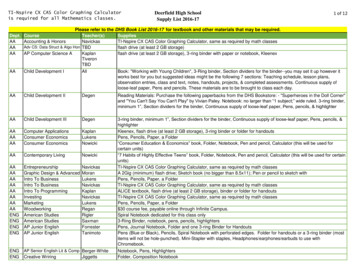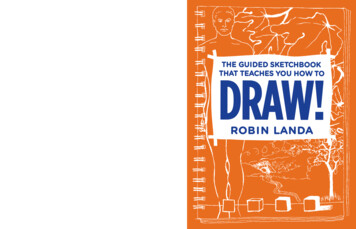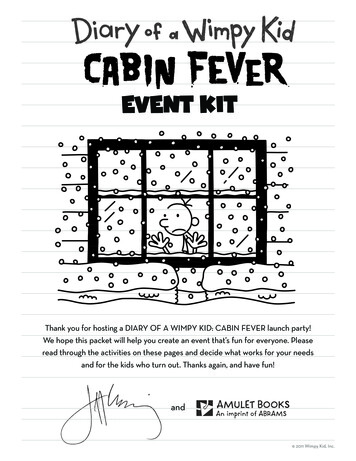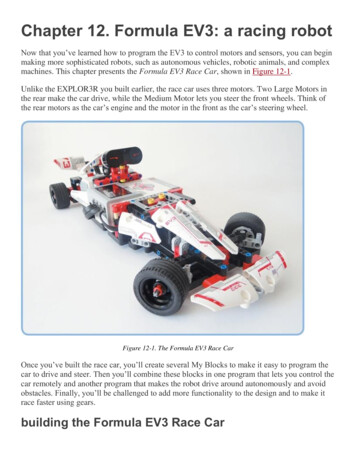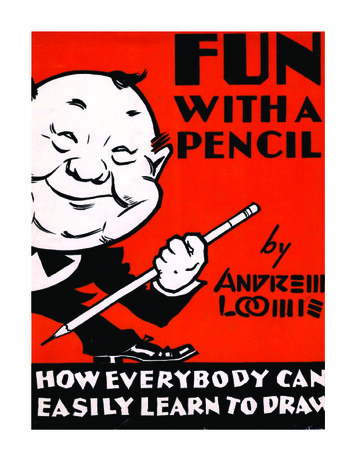
Transcription
1
FUN WITH A PENCILALSO BY ANDREW LOOMISFigure Drawing for All It’s WorthCreative IllustrationDrawing the Head and HandsThree-Dimensional Drawing2
Spacer3
FUNWITH A PENCILANDREW LOOMIS4
COPYRIGHT 1939 BY ANDREW LOOMISFIRST PUBLISHED BY THE VIKING PRESS IN MAY 1939BY THE MACMILLAN COMPANY OF CANADA LIMITEDREPRODUCED FOR EDUCATIONAL USE IN DECEMBER 2001All drawings and text within this book are the property oftheir respective copyholders and should not be reproducedfor any reason. They may only be used for thepurpose of practice and study.5
DEDICATED TO EVERYONE WHO LOVES A PENCIL6
MR. WEBSTER DEFINES DRAWINGAS DELINEATION. THAT DOESN’TTELL YOU HOW MUCH OF A REAL“BANG” THERE IS IN IT. MAYBEHE NEVER KNEW. MOST FOLKSLOVE TO DRAW EVEN WHENTHEY KNOW LITTLE ABOUT IT. ITSTARTED WITH THE CAVE MAN,AND STILL SURVIVES ON THEWALLS OF PUBLIC PLACES. BECAUSE IT’S SO MUCH FUN, ANDSO EASY, IT’S A SHAME NOT TO BEABLE TO DO IT BETTER.ANDREW LOOMIS7
ALL THAT YOU NEED TO KNOW, TO STARTTHIS BOOK, IS HOW TO DRAW A CIRCLE. . . .And it can be as lopsided as the family budget, andstill work out.Don’t start out with that old gag, “I couldn’t draw a straightline.” Neither can I, freehand. If we need a straight line, wecan use a ruler. Now please try it, just for fun.8
HOWDYFOLKS!Who am I? Oh, just one of Andy’s little funny folk.But I’m important! He gave me a job. I’m the spiritof the book, by jeeminy, big nose and all. I representall the blue in here. My right name would be BasicForm, but that’s much too high-sounding. He thinksthat name would scare you away. So he just calls me"Professor Blook’’ and lets it go at that. Now, I’ve gota few interesting things to tell you.9
Since Andy cannot talk to you personally, he put me inhere so we can really get together. It’s tough on Andy,for that guy really loves to talk, especially "shop talk.’’Now this plan of action is based on the use of simpleforms that are already known and familiar to you, andwhich you can certainly draw.From these simple, known forms, we build otherforms, which without some constructive plan wouldbe too complicated to draw. For instance, the top ofthe head, or cranium, is nearer to a ball in shapethan anything else. So we start with a bull, and addto it the shapes we want. We thus "arrive’’ at the outlines that are needed instead of guessing at them. Onlythe most talented end experienced artist can draw atonce the final outlines. That procedure is most difficult, and is the reason most people give up drawing.But knowing how to "construct’’ makes drawing simpleand easy, and a delightful pastime to anybody. By building preliminary shapes and developing the outlines onthem, we know WHERE TO DRAW OUR REALLINES. There is hardly anything that cannot first beconstructed by the use of simple forms.“Santa had a belly, like a bowl full of jelly.’’ Now thatwas a real observation. We know just whet it must hovelooked like. In fact we can see it shaking! Now, the ideais to draw the bowl before the belly. If the observationis correct, it ought to be a simple matter to make it fairlyconvincing as an abdomen for old Nick. Of course wewill cover it with his coat and pants, but we’ll be prettysure the pants don’t spoil the big idea. Ipicked on Santa because he’ll never complain that I’mbeing too personal over his appearance. I might justas well have chosen your next-door neighbor, his lunchbasket may be equally rotund, and shake some too.Every form is like some simpler form, with this or thatvariation, and with pieces added on. The simplest10
Forms we know are the sphere, the cube, and the egg.Before we could walk we recognized the sphere inDad’s new golf bulls; the cubes were in the sugar bowl;as for the eggs, well, the nicest ones were Easter eggs.I say, “Draw a line.’’ You cannot know just what Imean. A straight line? A curved line? A jagged line? Awiggly line? There are a thousand kinds of lines; bemore specific. But it I say draw a ball, a cube, an egg,a cylinder, a pyramid, a cone, a rectangular block, ineach case the image you get is perfect. You know exactly what I mean. Instead of “line,’’ we shall think interms of concrete and tangible “form,’’ and proceedas if we were handling lumps of clay. You can appreciate the value of such a method, for you know the fundamentals even before you start; they are obvious toanybody. If you never saw a ball, you should quit rightnow.As you proceed to build all sorts of shapes out ofsimpler ones, it is amazing what you can do withthem, and how accurate and "solid’’ the resulting drawings will appear. The surprising part is that, when theconstruction lines are erased, very few could guess howit had been done. Your drawing appears us complicatedand difficult to the other fellow as mine might seem toyou now. It takes on a look of professional workmanship, which indeed it has, since the professional artisthas by some method had to “construct’’ his work tomake it “professional.’’If you will give the following pages even your amusedattention, I am satisfied you will find much that willsurprise you in the way of ability but perhaps you heretofore never guessed you had. If it absorbs your interest, you might find yourself clever enough to amazethose about you. Just now take my word for it that themethod is simple, practical, and, I believe, possible foranybody to follow.11
TAKE A GOOD LOOK AT THIS PAGEA circle is a flat disk. If you draw the “inside” contours, itbecomes a solid ball, with a third dimension. We shallbuild other forms, like lumps of clay, onto this solidity.The construction will be erased, but the solid appearancewill remain, giving form or the appearance of reality.12
PART ONEHOW TO DRAW FUNNY FACESGet a pencil and paper quickly! Draw lightly all you see printed inblue. Take one stage at a time, on one drawing, until the last stage;then finish, with strong lines over the light ones, the lines we haveprinted in black. That is all there is to learn! These are "selected’’ or"built in’’ from the basic forms. I call the basic drawings “Blooks,’’after myself .13
HERE WE GO!I promised you that all you need to know, to start this book, is how to draw alopsided ball. Whatever shape you draw can be used as a foundation for a funnyface. Do the best you can, even if the ball looks more like a potato.14
THE FUN STARTS!The big idea is to start with a “form.” Then develop other “forms”on it. Build your final lines in by selecting, eliminating the linesyou do not use. I leave mine in to show how it’s done.15
A SURE METHOD FOR ANYBODY16
IT’S REALLY GOING TO BE EASIER THAN YOU EXPECTEDNow, if the first drawings you do are not the last word in cleverness, don’t bediscouraged. You will soon get the idea. When you begin to sense form, youwill have the whole works. Then we’ll polish up, and they will have to admityou are good.17
THE “BLOOK BALL”If you will now turn back to page 12 and look at the string of balls, you will seethat we are getting right into big business. You need some practice on these.Never mind if they are a little off.The better you can draw these balls in any old position you wish, the better youare going to be. The line from the top to bottom is the “middle” line of the face.The horizontal line, which looks like the equator, is the “eyeline,” and it alsolocates the ear.18
JUST PRACTICE ON THESE “BLOOKS”19
THE BEST WAY TO GO ABOUT IT20
WE ADD ANOTHER LINE TO THE BALLLook at the diagram. This last line goes completelyaround the ball, thought the axis at each end, and cutsthe eyeline just halfway round on each side of the middleline. The ear joins the head at the point of intersection ofthe eyeline and the earline.21
THERE IS NO LIMIT TO THE VARIETYI am a lot more anxious to have you understand the method andcreate your own forms than to copy mine. But copying minenow will get you started.Always construct the head from the cranium down. There is noother satisfactory way. You can see by now that the position ofthe ball determines the pose of the head. The pieces you buildon determine the character.22
“BLOCKY” TREATMENT LENDS CHARACTER“Blocky” shapes always combine interestingly with round shapes.It is a good idea to make the final lines angular even around curves.It gives a sense of bone and ruggedness of character. You wouldnot do this when drawing pretty girls or babies.Now I’ve got a surprise for you. Instead of drawing all therelunkheads, let’s try something real. I’m going to pose for you.23
BLOOK POSES24
EXPRESSION25
EXPRESSION26
DIFFERENT EXPRESSIONS OF THE FACE27
TRICK STUFFTry this on the folks. Tell them draw two overlapping circles, anysize. Draw a middle line through both and build on your own pieces.You can make a head out of any combination. Of course, tell themto draw lightly.28
TRICK STUFFDraw a circle. Attach two smaller circles, not far apart, anywhere. You can put a third above and between them. Thendraw the middle line so it passes between the two small circles.Proceed as usual.29
HERE’S A STUNTDraw three balls, one of them small, in any position. Connect the larger balls. Draw a middle line under the small ball.This suggests a head. Now use your imagination to completethe drawing.30
DON’T MISS THIS PAGEHere we combine the ball with other basic forms. With “solidforms” to build on, the head begins to take on more reality.You can almost anything you want to with the supplementary forms, and come out all right. The is real character drawing, and a challenge to you.31
PROJECTIONThis page is for the clever folks. It is a method of projectingthe characters you have created into various poses. Try it withvery simple heads at first. You must use your eye and buildvery carefully.32
VARIETY BY DISTORTIONTake any head. You can distort it by the following methods.This is valuable in caricature. You can trace a photo, and drawfrom the tracing, or take any of your own drawings and distort them.Here again is a chance for your own invention. Draw a squarearound your subject. Divide each way into eight or more parts.If you wish to distort separate features, change the size of thesquares into which they fall. Make the line cut through eachsquare as it does in your copy, but changed to fit the newproportion of your squares. 1/2, 1/3 square, etc.33
BABIES34
BRATS35
THE DIVIDED BALL AND PLANE METHODThe Method Developed by Andrew Loomis, Which MakesConstruction Simple for Any Type of Head.We go now into the most important section of thebook. The method here worked out is a development of the simple groundwork you have alreadyaccomplished. It need not frighten you, since it isbut slightly more complex than the work up to thispoint.The cranium, as you perhaps have realized, is nevera perfect ball in shape. To draw it correctly we mustmake alterations, some slight and others quite exaggerated, to fit the various types of skull. Nevertheless, we can take as a basic form a ball sliced off atthe sides, leaving it a little wider one way than theother, and adding to it or taking some away. Theforehead may be flattened, cut down, or built up asthe case may be. The cranium may be elongated,widened, or narrowed. The facial plane may also bealtered as we see fit without destroying our workingprinciple. The plane simply attaches to the ballwherever we want it, which makes our methodentirely flexible, so that we can represent any typeof head we choose. All other methods I have yet seendo not start with a form anything like the skull, ormake any allowance for the variety of shapes.36After this book was published, I learned with interest that a similar basichead form has been used foryears by Miss E. GraceHanks of the Pratt Institute, Brooklyn, and that shehas written a book basedon this method.
THE DIVIDED BALL AND PLANE METHOD37
THE DIVIDED BALL AND PLANE METHODIt is this flexibility and freedom built into themethod that should make it of certain value. Onpage 37 I have given a set of measurements I consider ideal, but these need not be adhered to. Tome the real value of the method is that it makespossible the accurate construction of the headwithout copy or model or, when a model is used,that it allows you to render the type recognizablyand with certainty. It possesses powers of exaggeration for comic drawing and caricature as wellas of serious interpretation. It opens an avenue ofapproach to the novice, dispenses to a large extent with the necessity for tedious and prolongedstudy, and gives almost at the outset the muchneeded quality of solidity which usually comesonly with a knowledge of bone and muscle structure.If you glance at page 39, it will be evident howthe ball and plane is designed to give that appearance of actual bony structure. The skull lies withinthis basic form. But over and above this in importance is the helpful guidance it gives in placingthe features in their correct positions, in relationto the pose of the head. This will come veryquickly, and soon the eye will detect anythingobviously “out of drawing.”Many years ago I sensed the lack of any methodof approach having any marked degree of accuracy. I was told to draw the head as an egg or oval,and to proceed from there. Fine for a straight frontview. But what of the jaw in a profile? There isbut a slight hint of the skull formation in an eggshape alone. Again, I was told to build the headstarting with a cube. While this aided one in sensing the perspective, it gave no hint of the skull.How much of the cube was to be cut away? Sincethen I have heard of “shadow methods” and others, yet in every case a previous knowledge of thehead was necessary.38
THE DIVIDED BALL AND PLANE METHOD39
THE DIVIDED BALL AND PLANE METHODWhat I wanted was a method whereby, if a headlooked wrong, I could find out what was wrongwith it, Tampering with a painted head to correctsome bad construction or drawing usually ruinedthe work done. The necessity of starting the headcorrectly in the first place was obvious, so that thefinishing could be approached with the confidencethat after hours of work it would not go “sour.” Withclosing dates of publications imminent, it is riskybusiness to proceed without a full knowledge ofwhat you are doing.So this method evolved from personal necessity. Imight state here that in the beginning I had not theslightest intention of putting it in book form. However, when the plan did work itself out finally, Iwas struck with its simplicity. It was one of thoseinstances that make you wonder why you or somebody else had not thought of it before. The fact thatit tied up with our first childish scribbles, whichafter all are a crude statement of form unhamperedby superficial detail, only increased my enthusiasm.Why, then, could not such a plan be made available to all, from the child scribbler to the professional artist? The plan changes but slightly fromthe first round ball and added forms to the professional piece of work, the difference lying in theability of the individual. It all hinges on the properbuilding of the ball and its divisions. Approachedwith the understanding that one is drawing solidsinstead of lines, the method becomes surprisinglysimple.I do not doubt but that these few pages will proveof inestimable value to many practicing artists, whoI know have been confronted with the same difficulties of bad drawing and closing dates. But primarily the book is for John Jones, who alwayswanted to draw but could not.40
AS APPLIED TO DIFFERENT TYPES41
SOME HEADS BASED ON PAGE 41This page must give you some idea of the unlimited variety of types and characters possible through building bythe Divided Ball and Plane method. There are thousands oftypes, and each looks different mostly because of the skullrather than the features. It’s fun to study an individual, andtry to figure out what kind of ball and plane go together tomake up his face. You really learn to look deep into character, and beneath the surface. This method calls for no clairvoyance, but a quick eye and a skillful hand.42
COMIC HEADS BY THE DIVIDED BALL AND PLANEThe above are simple applications of the method. These are nomore difficult than by the previous plan of attaching formsdirectly to the ball. However, the chance of error is greatly lessened. You might as well have the complete method as part ofit. Time spent on these pages will prove of sound value to anyone sincerely interested in the drawing of the head. It is suggested that you go on with the book and come back to thissection at intervals. As you try you will improve. By all meansdo not give up. That hand of yours will be doing surprisingthings before long.43
THE PRETTY GIRLA pleasing head of a girl depends ninety-nine percent on how wellyou draw it. More exactly, the ball must be drawn well, the construction lines correctly placed on the ball and plane, and the features nicely placed. Remember there is the width of an eye between the eyes. Do not place the mouth too low or get the nose toolong. I have used a pen here. Try it sometimes.44
A METHOD OF CHECKINGThe blue lines in the diagram above are our same construction lines.They may be done on tracing paper over any face. You can thus quicklyfind a feature that has been incorrectly placed. You can also “find” theball and plane position in a photographic head this way. Whether youare building or tearing down, the method applies.45
THE WOMEN FOLKS46
TWENTY KIDS47
ETERNAL YOUTH48
THE OLD FOLKS49
OH, BOY, OH, BOY! NOW THE FUN REALLY STARTS50
PART TWOPUTTING THE HEAD ON THE BODY51
THE COMIC FIGUREYou know, I’ve a hunch you have been itching toget into this portion of the book. Well, it is reallygoing to be great fun to create little people of yourown, doing anything you want them to. There isnothing hidebound in this plan either. Take it in easydoses for the fun that’s in it. Whether the folks youdraw will ever bring home the bacon is a matter ofcircumstance and how clever you get to be. But it’sworth the effort to get that bang out of being able todo it.When you were a very little boy or girl your brainchildren probably looked like these. If they did,you had a great deal of undeveloped talent, and ifyou have not been drawing ever since, it’s a realshame. When the little youngster starts to draw,he instinctively does a better job than he does lateron. He goes to essentials, a crude representationof the bulk without the detail. Soon he forgets thebody and starts drawing buttons and clothes witha face on them. Result: he gets discouraged andtransfers his attention to some pretty blond curlsor a new bicycle.In all seriousness, I say that Nos. 1 and 2 of themarginal drawings have great possibilities; 3 and4 still have hope. But 5 verges on those awful drawings in public places.52
Now we start with something very much like 1 and 2.For want of a better name we shall call him“Doohinkus.” All we need do is add some sort of boxfor a pelvis, some pads for hands and feet, some ballsat the joints, and a straight line across for shoulders.We thus give him the following characteristics.Head is a ball.Chest is a ball.Pelvis is a box slanted out at back and in at the sides.The spine does not go through the chest ball butaround the back of it.The legs are not straight but curve in to the kneesand out toward the foot.Forearm is slightly curved.Chest ball is divided by a line through the middleand flaring lines at the bottom, like a Y upside down.The reason for the curve on the bones is that theythus become “springy” and shock-absorbing.Without those curves we would be nervous wrecksbefore we were in short pants or panties as the casemay be.Every limb is movable in practically all directions.The chest ball is fixed to the spine but the spine bendsin all directions. It can also twist or turn, so that thereis a wide range of movements possible between spineand pelvis.The human body is just about the nicest bit of mechanics we have in the world. We can walk, run, jump,climb, stand erect, sit, all without any oiling or burntout sparkplugs. Our motor starts and stops once. Ifwe take care of the engine it will outlast any metalone. Let’s go!53
HERE WE GO!The proportions of your little figures may be varied in anysort of way. Below we show a variety of comic exaggerations.54
WE START ON THE FIGUREWe shall start at once to put them into action. There will alwaysbe movement of the parts. Draw this page carefully and becomethoroughly familiar with the movement of each part.55
DOOHINKUS MOVES ABOUT. STUDY THE FRAMEWORK56
PURPOSELY OFF BALANCE57
DO SOME OF THESE58
TRY THESE, THEN INVENT SOME OF YOUR59
BUILDING ON THE FRAMEWORK60
A WAY TO SET UP THE ACTIONTake any jointed doll if possible, one jointed at thewaist. This fellow was a plain wooden art-store mannikin. In order to make him exist for you as something more than wooden chunks, I dolled him up, withpaint, putty, and a bit of hair from the bathroom rug.Then I got busy with my candid camera. He is a queerlooking little guy, a sort of cross between GrouchoMarx and a cigar-store Indian; but he is made of parts,and it is the appearance of these parts in action thatwe are interested in. In this way Doohinkus Mannikin is better than a live model. The black lines onhim help you his bulk, just as they do on the ball.Take some of these poses. Start by drawing the framework in the approximate action. It is not importantthat you maintain the same proportions, and you cansubstitute any head. Change him to suit yourself, butwatch the positions of the parts carefully. Build oneach part as you it. Note whether lines at joints curveup or down, how the part is tipped toward or awayfrom you, you can exaggerate the action of the hipsand shoulders, as those actions were quite limited inthe mannikin. You can also, if you wish, render thelight and shadow on the parts.Tracing these, or copying without building, will doyou no good. But if you will “build” a dozen or so,you will be able to set up figures of your own, in almost any action. The correct assembling of the partsof the figure is much more important than actualknowledge of the bones and muscles. You cannot putclothes on your figures properly without knowing theaction of under the clothes, and the flexing and pulling of the material over them from one part to another.Pages 66 and 67 will show how to go about it.62
DOOHINKUS MANNIKIN SHOWS YOU THE PARTS IN ACTION63
BUILD FIGURES FROM THESESTART WITH THE FRAMEWORK64
AFTER DRAWING THESE, TRY SOME OF YOUR65
HOW YOU USE THE DOOHINKUS POSESHere is the way to go about the preceding poses. I have chosen figureNo. 8 at random. First, it is a good idea to know what the normalfigure is like. You needn’t draw this unless you are interested. Thebottom figures illustrate how the exaggerated is based on the normal.66
JUST PLAY WITH THE FIGURESThe main idea is to enjoy yourself. Some day you may justput clothes right over the framework. But it is better alwaysto sketch in the figure. Do not follow the photos literally. Doa lot of inventing, I wish I had more space here, but perhapsthese will give you a working basis.67
THE SUIT68
THE DRESS69
HOW TO DRAW A HAT CORRECTLY70
FREAK HATS71
THE HAND72
FEET73
NOW WE BUILD THE FIGURE AND PUT ON SOME CLOTHES74
EXPERIMENT ON FELIX THE ICE75
TRICK STUFF76
TRICK77
NOW HAVE SOME FUN78
TRY TO WORK OUT THE CONSTRUCTION YOURSELF79
EXPERIMENT WITH THESE80
I’M PUTTING YOU ON YOUR OWN81
NOW LET’S MIX UP THE RACES84
ALSO THESE86
AMONGUSMORTALS87
FORESHORTENINGUnless one has a sound method of building,foreshortening is very difficult. In the figure at theright, the parts resemble the Doohinkus photos. Ifyou think of the figure as sections fitted together,foreshortening takesfully as we built the head in Part One. Think ofsolidsBelow, we obtain foreshortening by projecting a profile into a front view, or the reverse, as we did withthe head. Establish the desired tilt and position ofthe parts, then by parallel lines build the other position of the figure so that all important points coincide. When the figure is close, increase the partsthat are closest and diminish the parts that are awayfrom you. I did not do this, fearing it might confuseyou. I personally prefer the method at the top, using the eye, but often a difficult problem can beworked out easily this way, and it is well to knowhow.94
PART THREEA WORLD FOR YOUR FIGURES TO LIVE IN97
PERSPECTIVE98
HOW TO ESTABLISH FIGURES ON THE GROUND99
COMMON FAULTS101
FURNITURE102
HOW TO PROJECT FURNITURE ONTO THE GROUND PLANEHere is an excellent method for building furniture and figures on a ground plane. Itis simpler103
BUILDING AN INTERIOR FROM A GROUND PLAN-I104
BUILDING AN INTERIOR FROM A GROUND PLAN-II105
BUILDING AN INTERIOR FROM A GROUND PLAN-III106
BUILDING AN INTERIOR FROM A GROUND PLAN-IVBEDTIMEAnd here is the finished drawing. It’s fun to try inking in some of yourpencil drawings. Get a bottle of waterproof black drawing ink. Youcan get a box of school water colors, also, and get still more fun outof it. Knowing just what is the correct perspective helps so much togive that solid, finished, and professional look. This procedure opensup a whole world for the little figures you have learned to draw. It isworth while to see what you can do with this method. It offers a possibility of setting some work, besides the thrill of doing it. Now we shalltake up a new subject.107
LIGHT AND SHADOW: THE PRINCIPLERays of light travel in straight lines. From any spot, the middle ray, the “perpendicular to source,” would meet the earth and pass through its center. At thepoint directly under the source we establish the point DL, meaning “direction oflight.” S will mean “source” at the top of the perpendicular,From the farthest limit of the shadow to DL, then up to the source and back to theshadow, forms a triangle. The third corner of the triangle will be called At, meaning “angle of light.” DL may be the vanishing point of the shadow or the base fromwhich it proceeds outward.108
A SIMPLIFIED METHOD FOR GROUND SHADOWS109
LIGHTANDSHADOW110
LIGHTANDSHADOW111
THE LAST HILLI have a chosen a problem here that would be very difficult without some understanding of the fundamentals given in Part Three. By the use of perspective, together with the effect of light and shadow, we create the illusion of space, form, anda quality of existence.This drawing may have the “feel” of having been sketched from life, because of thefundamental principles applied to it. However, it was done from the imagination,without any copy, simply to show you the possibilities.It is a great storehouse of material. By all means, draw from that great source. Donot just copy. “Build” with what you observe for yourself to be true. Try to get theindividual quality of each thing you draw. It is that quality that makes the artistinteresting.113
TIME’S UP, FOLKS. WE GOTTA GO. ‘BY.114
THE AUTHOR’S CORNERI guess all you folks will forgive me for reserving a tinycorner of the book as my own. Everything must eventually come to an end, and so with this book, my first effortof this kind. It has been a concentrated effort. At times Ihave seen the daylight fade and come back again without sleep. I’ll never tell anybody the actual time it tookme to make these (it seems) thousands of drawings. I’msure he would not believe me. I’m dreadfully tired butimmensely happy. It has been intensely interesting, for Ihave retraced the ground of years ago. It has carried meback to the first struggle for knowledge that might earnme a living. It has reminded me of the early drawingswhich so often came back.How simple it all might have been, had I in the beginningbeen able to assemble these working principles, put themin order, and work with them as I do now. But they werebits of knowledge plucked out of the air like bits of flufffrom a seed pod. Only a few within your grasp, just afew to take root and flourish. Strangely, the simplest factsalways are the latest in being understood. And when theyare. Their utter simplicity is the best reason for theiracceptance, even at the cost of having to sweep out thepet theories and ideas accumulated over half a lifetime.At best, how do I know that I’m any more right now thanin my student days? The answer is that of the convalescent who has suffered and got well again. Lack ofknowledge can be greater torture than the effort of acquiring it. I know only that I am happier in my work thanI was then. It has gained publication in places that onceseemed hopeless for me. I can approach the work withpeace of mind and confidence boon of experience. Thisbook is an effort to transplant that peace of mind to somefew thousand others who otherwise must fall victims tothe selfsame devices which contrive to make before theycan make even a meager start.115
118
I can think of no field of endeavor so sadly lacking in simpleorganization of its working principles. Nothing quite so haphazard, hit-or-miss, as the whole field of artistic endeavor. Iam not a cartoonist, but I choose caricature for the beginner:principally because there is fun in it, and from the start Iwant him to feel a little of the creative joy he is entitled to.When artists begin to compile and set down their combinedexperience, give freely and humbly what little they can add,as do the other sciences, then art may have some chance toreestablish itself in the hearts of everyday people even againstthe mechanical perfection of the camera; even in a period ofsocial adjustment and financial depression. The mental depression of our era weighs heavier on our race and futurethan do our dollars or lack of them. A little joy from the inside must be welcome to
Oh, just one of Andy’s little funny folk. But I’m important! He gave me a job. I’m the spirit of the book, by jeeminy, big nose and all. I represent all the blue in here. My right name would be Basic
